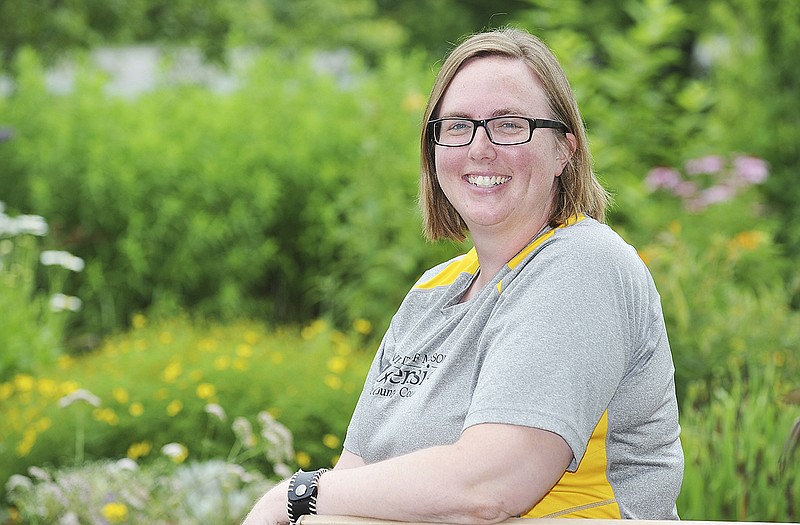She was active in a 4-H program in her native Carrollton, Ill., but the young Jenny Flatt didn't envision growing up to work with the program full time.
"I wanted something different for myself - I wanted to be able to grow and develop a little bit" away from the family farm, she recalled last week.
"My dream was, I was going to be a journalist for the New York Times."
So she left rural Illinois for the University of Missouri's Journalism School - and changed her career ideas after one semester.
"I wrote an article for the Maneater, which is the campus newspaper," she said. "But it was not similar to what I actually had written, at all.
"Through copy editing and that process, my original intent was not even there - so, I got a little disillusioned, and I thought, "Maybe if I want to save the world, I want to do it on a more personalized level.'"
So she majored in psychology and sociology, graduating from MU in 2005, "and then I decided that I wanted to be a teacher," she said.
She earned a master's degree in education from MU, and "did everything except student teach and certify, and I went to find a job - and found the Extension job."
She moved to West Plains and began working with 4-H youth in five different counties.
"It wasn't something that I grew up thinking, "I'm going to be an Extension agent,'" Flatt said. "I hadn't connected the fact that University Extension was a part of 4-H.
"A lot of people don't make that connection - they just think that 4-H is a separate entity."
After three years in Howell County, she moved to Jefferson City - and now is a youth development specialist for 4-H programs in Cole, Callaway and Osage counties.
"I coordinate and manage volunteers," she said. "Often people think, "You work a lot with youth.'
"But the reality is, that most of what I do is help volunteers become successful, with volunteer training, volunteer management - which means helping them connect with kids."
Working with the adult volunteers "provides me an opportunity to affect kids in a way that I wouldn't, otherwise, because what we get is a lot of different expertise levels from the adults," she said, "that I wouldn't be able to bring to kids."
Still, Flatt works with students from time to time, like the art camp at the end of June and the coming county fairs.
"It is worthwhile," she said, "because those are the times I get to see kids, get to see the work they've been working on all year - and get to see their families."
Flatt has a higher public visibility this time of year because of the fair activities.
And she considers what she does with kids and adults to be a form of the teaching profession she once aimed for, "but my role is much more than that," she said. "As a teacher, I wouldn't be going on the radio, or some of the marketing things that we do, or grant writing or things like that.
"And I like those challenges."
Like other youth organizations, 4-H operates through clubs and "is about youth development. We're project-based, throughout the year," Flatt said.
Fall is the organizing time for the students and their adult volunteers. Spring is the time for little camps, she said.
Flatt tries to visit each club at least once each year - usually in the fall, and that's a total of 38 clubs in the three counties she serves.
And summertime is the time for more camps - and for the youth to show off their year-long projects at the county fair or other competitions.
The programs have changed a lot over the years.
"When I was a kid, growing up in a very rural area, our opportunities were to do livestock projects and sewing and cooking and knitting," Flatt said. "Today, we have kids who are involved in high-level robotics projects, that teach them about computer programming - and how to make this thing that may look like a washing machine do all sorts of things from bouncing basketballs to moving things around."
The goal of all the projects, whether building robots or raising an animal, is "mastery," Flatt said. "In 4-H, people think "mastery' is winning a ribbon - but for us, "mastery' is that you've learned something across time."
The most challenging part of her job is managing it, she said, because of the sometimes conflicting schedules of activities in three different counties.
The most fun part is watching kids present their projects, when "I know that youth development is happening and all the things that we've been working for - all the adults that we've been helping connect with kids - and I know that it's all worthwhile."
She makes time for her new family, as well.
"We spend a lot of time at track meets," Flatt said, watching her stepdaughter, 6, run in Columbia's community track program.
"And our son (14) is very involved with band."
She sometimes spends some quiet, personal time playing the piano.
Her many hours on the road help her "gear up, and gear down" from each day's work and issues.
"I work a lot of hours and with a lot of different people," Flatt said. "It's easy to forget why we're here (but) if we remember the kids are working hard and will grow up to be future adults - and we're fostering that future adulthood."

